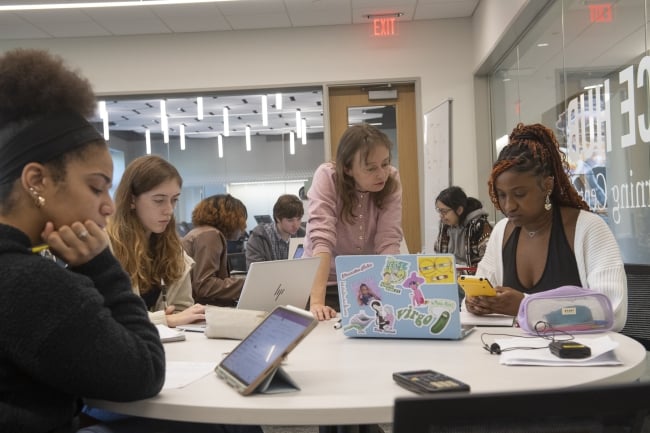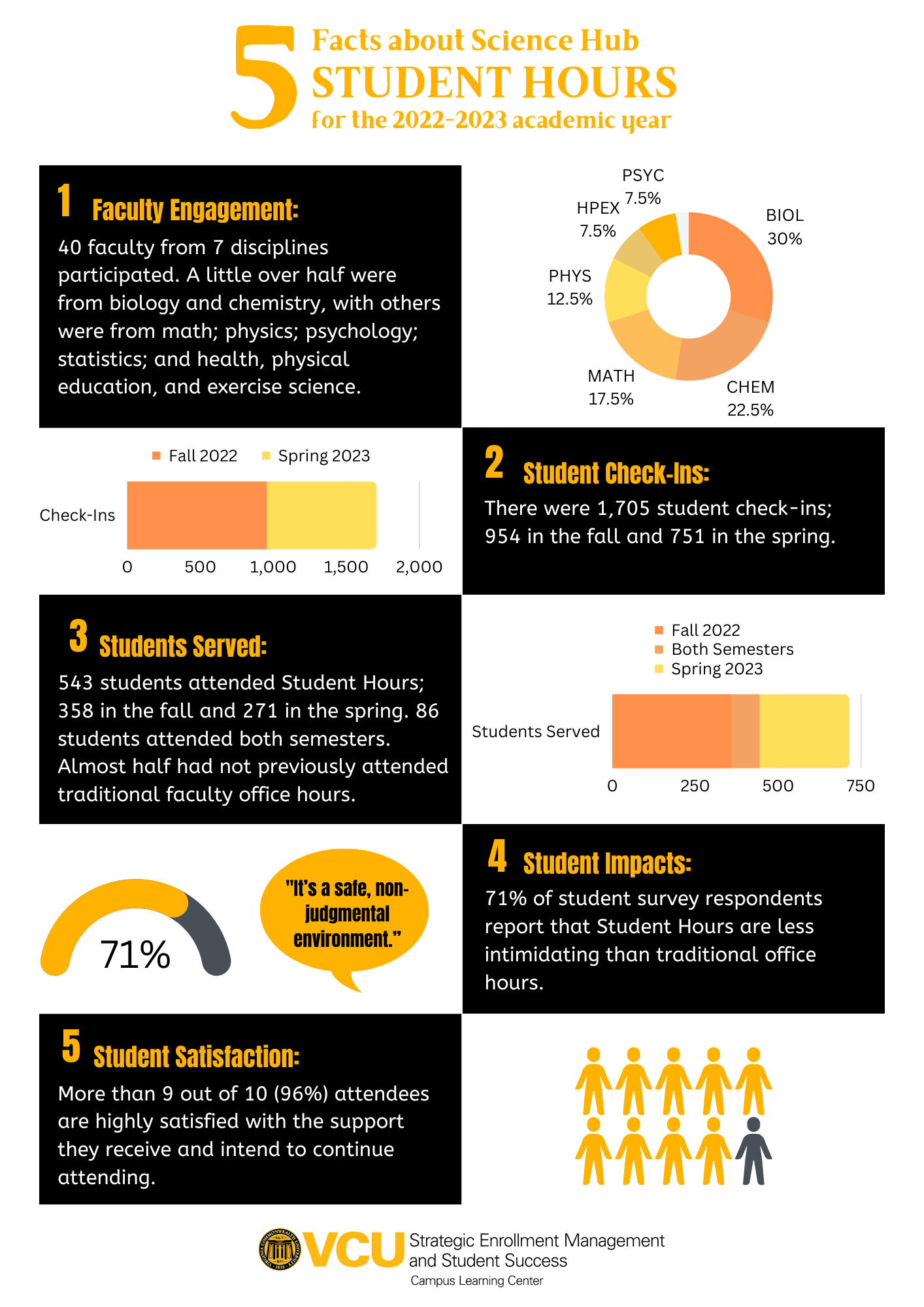You have /5 articles left.
Sign up for a free account or log in.

Students talk with faculty members and peers in the Virginia Commonwealth University Science Hub.
VCU
Encouraging students to utilize office hours can be a challenge for many faculty members. In a 2022 Student Voice survey from Inside Higher Ed and College Pulse, more than three in 10 student respondents at public institutions and two in 10 at private institutions reported never visiting professors during office hours. Different interventions can make the purpose of office hours more clear, and virtual or appointment-based hours can increase accessibility for students not on campus during the day.
To make office hours less intimidating for students, staff at Virginia Commonwealth University created “student hours,” a daily communal working space for multiple faculty members to meet with students across the STEM disciplines.
The pilot launched in 2018 in the library, and it has since grown, moving into a new space at VCU’s Science Hub this fall. Student and faculty feedback has shown an uptick in usage of office hours and a deeper sense of community.
The background: VCU received an Inclusive Excellence grant from Howard Hughes Medical Institute in 2018 that challenged colleges and universities to reimagine how they’re serving students and how institutional barriers can impact student success in the STEM field.
Michal Coffey, director of VCU’s Campus Learning Center, partnered with faculty fellows in the STEM field to imagine ways to strengthen student-faculty relationships and reduce pressures on students—and they considered the challenges of office hours.
“The idea of traditional office hours, going into somebody’s office, is really intimidating, especially as a first-gen student,” Coffey explains. “Even knowing, how do you enter an office, how do you greet somebody? Where do you sit? What’s the protocol for this? There’s so many unwritten rules.”
Instead, VCU flipped the model, calling it “student hours” instead, to create a space where students feel more comfortable without the unwritten rules of a professor’s office.
The pilot: Student hours initially launched in the library, utilizing a classroom-ish space four days a week for around two to three hours each day.
Coffey and the faculty fellows emailed STEM faculty members, letting them know about the opportunity and giving them a chance to sign up for a day and time. Faculty members sign up with a Google form, and most get their first choice of times, unless too many faculty members sign up for that day.
“The initial buy-in came from those faculty fellows,” Coffey says. “They were knocking on the doors of their colleagues, and they were like, ‘You’re gonna come with me, it’s gonna be great.’”
To advertise to students, the hours are posted on the Campus Learning Center’s website. Days and times remain the same week to week for the semester. Students sign in upon arrival to collect usage data, as well.
The format has proven successful, not only in creating relationships between students and their professors, but also in building faculty connections across the department to discuss curriculum or research.
VCU
New space: This fall, VCU opened its Science Hub on campus, dedicated to STEM subjects, which provides more space for students to connect with faculty members.
The Campus Learning Center owns space in the new facility, which allows for greater flexibility in offering student hours, Coffey says.
The new space also has resources such as whiteboards and round tables, which benefits groups of students showing up for office hours. “We have little breakout rooms if your group gets too big,” Coffey adds.
The center still operates between 8 a.m. and 5 p.m., but Coffey says student usage numbers have yet to dictate a need for expanded hours outside of that, and the center would need additional buy-in from faculty to manage later or earlier times.
The impact: More than 40 STEM faculty members are participating in student hours this semester. Some faculty members only offer drop-in appointments in the flipped format, but others do a mix, participating in student hours but also offering prescheduled appointments in their offices.
A recent survey of participating students found one-third of attendees had not attended traditional office hours prior to participating, and three out of five felt more comfortable attending student hours than traditional office hours.
The initiative also promoted belonging at the institution (58 percent) and within the STEM departments (63 percent) among surveyed participants.
In the future, Coffey hopes to have additional faculty members participate, with a goal of 50 in STEM. The staff would also like to grow opportunities for non-STEM faculty to participate in a similar setting, with the potential of using library space again to build up.
DIY: For a college or university looking to model student hours, Coffey offers five considerations.
- Find a faculty champion. Getting buy-in from the department starts with having people in teaching roles promoting and sharing the idea widely.
- Make it in-person. VCU shifted the model online during remote instruction in 2020 and 2021, but the format didn’t work as well as in-person.
- Invest in personnel. Hosting student hours (managing sign-ins, helping faculty members get resources and space for students) can be a considerable lift. Hiring student employees to manage the events can help alleviate staff burden.
- Manage space and size. Sometimes, a large group of students will participate in student hours on the day before an exam. Finding ways to manage noise and number of participants is critical to a productive work environment.
- Track usage. VCU collects student data, including which classes they’re coming from, to gauge usage among demographics and demonstrate success of the program, which Coffey believes is a best practice.
If your student success program has a unique feature or twist, we’d like to know about it. Click here to submit.





